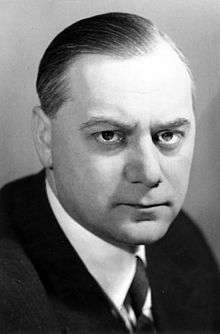German National Prize for Art and Science

The German National Prize for Art and Science (German: Deutscher Nationalpreis für Kunst und Wissenschaft) was an award created by Adolf Hitler in 1937 as a replacement for the Nobel Prize (he had forbidden Germans to accept the latter award in 1936 after an anti-Nazi German writer, Carl von Ossietzky, was awarded the 1935 Nobel Peace Prize). The award was designed by Hermann Müller and created in the form of a pendant studded with diamonds. In fact, it was so heavy that a special mount had to be created so that it would stay on the wearer's jacket. An extremely ornate presentation box contained the pendant and a wide red and white sash also complemented the award.[1]
There was an image of a Greek hoplite on the obverse of the prize medal and the lettering: FÜR KUNST UND WISSENSCHAFT (For art and science) was emblazoned on the medal as well. In addition to the medal and award sash, a cash prize of 100,000 Reichsmark was also given.
The total number of National Prizes awarded between 1937 and 1939 was nine, thus making this award one of the rarest awards given in the Third Reich, even rarer than the German Order. Due to the outbreak of the Second World War, no further awards were made.
Awardees
The German National Prize was awarded to a total of nine people.
1937
The award announcement was held on September 7, 1937 and the award ceremony took place on January 30, 1938 by Adolf Hitler in the Reich Chancellery. The first five winners were:[2]
| Birth | Death | Laureate | Notes | Posthumous? | Shared? | |
|---|---|---|---|---|---|---|
| 1878 | 1934 |  |
Paul Troost | German architect. | ||
| 1893 | 1946 |  |
Alfred Rosenberg | Member of the Nazi Party. | ||
| 1877 | 1957 |  |
Wilhelm Filchner | German explorer and discoverer of the Luitpold Coast and the Filchner-Ronne Ice Shelf. | ||
| 1861 | 1949 |  |
August Bier | Surgeon and the first to perform spinal anesthesia and intravenous regional anesthesia. Shared award with Ferdinand Sauerbruch. | ||
| 1875 | 1951 |  |
Ferdinand Sauerbruch | Surgeon and developer of the Sauerbruch chamber, a pressure chamber for operating on the open thorax, and new types of limb prostheses, which for the first time enabled simple movements to be executed with the remaining muscle of the patient. Shared award with August Bier. | ||
1938
The award announcement was made on 6 September 1938, the presentation by Adolf Hitler took place 30 January 1939 in the Chancellery. The winners of this second year were:[3]
| Birth | Death | Laureate | Notes | Posthumous? | Shared? | |
|---|---|---|---|---|---|---|
| 1891 | 1942 |  |
Fritz Todt | German engineer, senior Nazi figure, and founder of Organisation Todt. | ||
| 1875 | 1951 |  |
Ferdinand Porsche | German automotive engineer and creator of the first hybrid vehicle. | ||
| 1898 | 1978 |  |
Willy Messerschmitt | German aircraft manufacturer and designer of the Messerschmitt Bf 109, the most produced fighter aircraft in history. Shared award with Ernst Heinkel. | ||
| 1888 | 1958 |  |
Ernst Heinkel | German aircraft designer and producer of the Heinkel He 178, the world's first turbojet aircraft and jet plane, and the Heinkel He 176, the first rocket aircraft. Shared award with Willy Messerschmitt. | ||
See also
Notes
References
- Jörg Nimmergut: Deutsche Orden und Ehrenzeichen bis 1945. Band 4: Württemberg II – Deutsches Reich. Zentralstelle für Wissenschaftliche Ordenskunde, München 2001, ISBN 3-00-001396-2; S. 1910–1917.